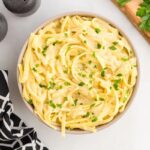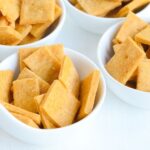Embark on a culinary adventure where creamy, dreamy dishes are achievable without a single drop of dairy! This guide unveils the secrets to transforming everyday recipes into decadent, dairy-free delights. Imagine velvety smooth sauces, perfectly moist cakes, and rich, flavorful meals, all crafted with ingenious substitutions and clever techniques. Prepare to explore a world of flavor possibilities, learning to harness the power of plant-based ingredients to create textures and tastes that rival their dairy-laden counterparts.
From mastering the art of cashew cream sauces to perfecting the delicate balance of dairy-free baking, we’ll delve into the nuances of texture and flavor. We’ll explore global cuisines that naturally embrace dairy-free cooking, offering a diverse range of recipes and inspiration. Discover the versatility of common pantry staples like nutritional yeast and avocado, transforming them into creamy wonders. This journey will equip you with the knowledge and confidence to create stunning dairy-free dishes that will impress even the most discerning palates.
Creamy Dairy-Free Sauces

Dairy-free cooking opens a world of creamy possibilities without sacrificing richness or flavor. This section explores three distinct dairy-free cream sauces, each offering a unique textural and taste experience, perfect for elevating your culinary creations. We’ll delve into the preparation methods, highlighting the nuances of each ingredient and offering tips for achieving flawlessly smooth results.
Cashew Cream Sauce
Cashews, when soaked and blended, transform into a luxuriously creamy base for sauces. Their subtly sweet and nutty flavor lends itself well to both savory and sweet applications.
- Soak the Cashews: Cover 1 cup of raw cashews with boiling water and let them soak for at least 30 minutes, or preferably overnight. This softens them significantly, resulting in a smoother, creamier sauce.
- Blend: Drain the cashews and combine them in a high-speed blender with 1 cup of water, 2 tablespoons of lemon juice, 1 tablespoon of nutritional yeast (for a cheesy flavor), and salt to taste. Blend until completely smooth and creamy, adding more water if needed to achieve the desired consistency. The resulting sauce will have a light beige color, a rich, nutty aroma, and a velvety texture.
- Season and Adjust: Taste and adjust the seasoning as needed. You can add garlic powder, onion powder, herbs, or spices to customize the flavor profile. For a richer flavor, you can add a tablespoon of olive oil or avocado oil.
Coconut Cream Sauce
Coconut cream, the thick, solidified part of coconut milk, provides an intensely rich and decadent base for sauces, particularly suited for curries and Southeast Asian-inspired dishes. Its inherent sweetness balances well with savory elements.
- Chill the Coconut Milk: Place a can of full-fat coconut milk in the refrigerator overnight. This allows the cream to separate and solidify, making it easier to scoop out.
- Scoop and Blend: Carefully scoop out the thick, solidified coconut cream from the top of the can, leaving the watery liquid behind. Place the coconut cream in a blender with your desired seasonings (such as red curry paste, ginger, garlic, or lime juice). Blend until smooth and creamy. The sauce will have a creamy white color, a pronounced coconut aroma, and a luxuriously thick texture.
- Simmer (Optional): For a more emulsified sauce, gently simmer the blended coconut cream over low heat for a few minutes, stirring frequently, to allow the flavors to meld. This also slightly thickens the sauce.
Silken Tofu Cream Sauce
Silken tofu, with its remarkably smooth and neutral flavor, is a versatile option for creating a creamy sauce base. Its mild taste allows the other flavors in the sauce to shine.
- Press the Tofu (Optional): While not strictly necessary, pressing the silken tofu for 15-20 minutes removes excess water, resulting in a thicker, creamier sauce. Wrap the tofu block in a clean kitchen towel and place a heavy object on top.
- Blend: Place the pressed (or unpressed) silken tofu in a blender along with your chosen liquids (such as vegetable broth or water) and seasonings (such as nutritional yeast, lemon juice, garlic powder, or herbs). Blend until completely smooth and creamy, adding more liquid as needed to reach the desired consistency. The sauce will have a pale off-white color, a mild, almost neutral aroma, and a smooth, velvety texture.
- Adjust Consistency: If the sauce is too thin, you can simmer it gently over low heat, stirring frequently, to thicken it. Adding a tablespoon of cornstarch mixed with a little water can also help to achieve a thicker consistency.
Dairy-Free Cream Sauce Comparison
| Cream Type | Nutritional Highlights (per 1/2 cup) | Flavor Profile | Best Suited For |
|---|---|---|---|
| Cashew Cream | High in healthy fats, protein, and fiber; good source of magnesium and zinc. | Nutty, subtly sweet | Pasta sauces, creamy soups, desserts (e.g., frosting, mousse) |
| Coconut Cream | High in saturated fat; good source of medium-chain triglycerides (MCTs). | Rich, coconutty, slightly sweet | Curries, Southeast Asian dishes, creamy soups |
| Silken Tofu Cream | High in protein, low in fat; good source of iron. | Mild, neutral | Sauces for vegetables, lighter soups, dips |
Dairy-Free Baking Substitutions
Baking without dairy requires thoughtful substitutions to maintain the desired texture and flavor. Many dairy-free alternatives exist, each with its own strengths and weaknesses, impacting the final product’s moisture, richness, and overall taste. Choosing the right substitute depends on the recipe and the desired outcome.
Successful dairy-free baking hinges on understanding how dairy contributes to baked goods. Butter provides richness, flavor, and helps create a tender crumb. Milk adds moisture and contributes to the structure, while cheese lends savory notes and contributes to browning. Replacing these requires careful consideration of each ingredient’s function.
Dairy-Free Butter Alternatives
Several excellent alternatives to butter exist for baking, each offering a unique profile. Vegan butter, often made from coconut oil or other plant-based fats, closely mimics the texture and flavor of traditional butter. Other options include refined coconut oil (for a neutral flavor) and applesauce (for added moisture, but potentially altering the taste). The choice depends on the recipe and the desired outcome. For example, vegan butter works well in most recipes, providing a similar texture and richness, while coconut oil might impart a subtle coconut flavor in some delicate items. Applesauce, due to its high moisture content, is best used in recipes that can benefit from added moisture, such as muffins or cakes.
Dairy-Free Milk Alternatives
Numerous plant-based milks are available, each impacting the final product differently. Soy milk, with its high protein content, often works well in cakes and muffins, providing structure and moisture. Almond milk, lighter in texture, might require a slight adjustment in the recipe to account for its lower fat content. Oat milk, increasingly popular, offers a creamy texture and mild flavor, making it suitable for many baking applications. The choice depends on the desired texture and flavor profile of the final product; for instance, soy milk’s higher protein content might result in a denser cake compared to one made with almond milk.
Dairy-Free Cheese Alternatives
Replacing cheese in baking is more challenging, as it often contributes both flavor and texture. Nutritional yeast, with its cheesy, nutty flavor, can add a savory element to savory quick breads or muffins. Vegan cream cheese alternatives, usually made from cashews or tofu, can be used in cheesecakes or other recipes requiring a creamy, spreadable cheese. However, these alternatives may not melt or brown in the same way as dairy cheese. Careful consideration of the recipe and the role of cheese is essential.
Dairy-Free Cookie Recipe Variations
This section explores three dairy-free cookie recipes, showcasing different dairy-free butter alternatives.
The base recipe for all three variations uses: 1 cup vegan butter, ½ cup granulated sugar, ½ cup packed brown sugar, 1 teaspoon vanilla extract, 2 cups all-purpose flour, 1 teaspoon baking soda, ½ teaspoon salt, and ½ cup chocolate chips.
Vegan Butter Cookies
This recipe uses vegan butter as a direct replacement for dairy butter. The result is a cookie that closely resembles traditional butter cookies in texture and taste.
Instructions: Cream together the vegan butter and sugars until light and fluffy. Beat in the vanilla. In a separate bowl, whisk together the flour, baking soda, and salt. Gradually add the dry ingredients to the wet ingredients, mixing until just combined. Stir in the chocolate chips. Drop by rounded tablespoons onto ungreased baking sheets. Bake at 375°F (190°C) for 9-11 minutes, or until golden brown.
Image description: A close-up shot of a plate of warm, golden-brown vegan butter cookies, still slightly soft and with melted chocolate chips visible on their surface. The cookies have a slightly irregular shape, characteristic of homemade cookies. Steam rises gently from the cookies, enhancing their warm, inviting appearance.
Coconut Oil Cookies
Substituting refined coconut oil for vegan butter results in cookies with a slightly different texture and subtle coconut flavor.
Instructions: Follow the same instructions as the vegan butter cookies, substituting refined coconut oil for the vegan butter. Note that the coconut oil might need to be slightly softened for easier creaming.
Image description: A plate of cookies slightly paler than the vegan butter cookies, with a crispier edge and a subtly different texture visible. The cookies are uniform in shape, reflecting the slightly firmer consistency of the coconut oil-based dough. A faint sheen from the coconut oil is visible on the surface of the cookies.
Applesauce Cookies
Using applesauce instead of butter results in a chewier, moister cookie with a less intense sweetness and a slightly altered flavor profile.
Instructions: Follow the same instructions as the vegan butter cookies, substituting applesauce for the vegan butter. You might need to adjust the flour slightly, depending on the consistency of the applesauce.
Image description: A plate of cookies that are darker and more intensely browned around the edges, reflecting the higher moisture content from the applesauce. The cookies have a noticeably chewier texture, and the chocolate chips are less prominent, slightly submerged into the cookie dough. The overall appearance suggests a denser, more moist cookie.
Comparison of Dairy-Free Butter Alternatives in Cookies
| Butter Substitute | Texture | Taste | Overall Impression |
|---|---|---|---|
| Vegan Butter | Similar to traditional butter cookies; soft and slightly chewy | Mildly sweet, buttery flavor | Closest to traditional butter cookies in both texture and taste |
| Refined Coconut Oil | Crispier edges, slightly firmer | Subtle coconut flavor, mildly sweet | Good alternative, but with a distinct flavor |
| Applesauce | Chewier, moister | Less sweet, slightly fruity flavor | Significantly different texture and taste; best for those who prefer a moister cookie |
Exploring Global Dairy-Free Cuisine
Many cultures around the world boast rich culinary traditions that naturally exclude dairy, often due to historical factors, religious practices, or readily available ingredients. These cuisines offer a wealth of inspiration for creating delicious and creamy dairy-free dishes, showcasing the versatility of plant-based cooking. Exploring these traditions not only expands our culinary horizons but also provides a deeper understanding of diverse food cultures.
Three Global Cuisines Featuring Dairy-Free Recipes
Three global cuisines that naturally feature a high number of dairy-free recipes are Southeast Asian, Ethiopian, and West African. These cuisines utilize an array of flavorful ingredients and techniques to create rich and complex dishes without relying on dairy products. Their dairy-free approaches are integral to their culinary identities, not merely adaptations.
Southeast Asian Cuisine: A Symphony of Spices and Fresh Herbs
Southeast Asian cuisine, encompassing countries like Thailand, Vietnam, and Malaysia, often relies on coconut milk, soy sauce, and an array of aromatic herbs and spices to create creamy textures and vibrant flavors. Dishes like Thai green curry, Vietnamese pho (often made with a vegetable broth), and Malaysian laksa showcase the region’s masterful use of plant-based ingredients to achieve rich, satisfying meals. Coconut milk provides a natural creaminess, while lemongrass, galangal, and chilies add layers of complexity.
Ethiopian Cuisine: The Power of Berbere and Niter Kibbeh
Ethiopian cuisine offers a stunning example of dairy-free cooking. The staple dish, wat, is a flavorful stew often made with vegetables, lentils, or meat, seasoned with the vibrant berbere spice blend. The stews are traditionally served with injera, a spongy flatbread made from teff flour. Niter kibbeh, a spiced chickpea stew, is another example of a rich and hearty dairy-free Ethiopian dish. The use of berbere, a complex blend of chilis, spices, and herbs, lends a deep, earthy, and subtly sweet flavor profile. Injera itself provides a unique textural contrast, acting as both utensil and accompaniment.
West African Cuisine: A Tapestry of Flavors and Textures
West African cuisine utilizes a wide variety of ingredients, including nuts, seeds, and vegetables, to create rich and flavorful dairy-free dishes. Dishes like groundnut stew (made with peanuts), okra soup, and fufu (a starchy dough) are staples in many West African countries. These dishes often feature complex flavor profiles achieved through the combination of spices, herbs, and the natural earthiness of the ingredients. The use of palm oil adds a distinct richness and flavor.
Detailed Recipe: Ethiopian Niter Kibbeh
This recipe showcases the vibrant flavors and textures of Ethiopian cuisine without using any dairy.
Ingredients:
- 1 cup dried chickpeas, soaked overnight
- 1 large onion, finely chopped
- 2 cloves garlic, minced
- 1 tablespoon ginger, minced
- 1 teaspoon berbere spice blend
- 1/2 teaspoon turmeric
- 1/4 teaspoon cayenne pepper (optional)
- 1 teaspoon ground cumin
- 1/2 teaspoon ground coriander
- 1 (14.5 ounce) can diced tomatoes, undrained
- 2 cups vegetable broth
- Salt and pepper to taste
- Vegetable oil for sautéing
- Fresh cilantro, for garnish (optional)
Instructions:
- Drain and rinse the soaked chickpeas.
- Heat a tablespoon of vegetable oil in a large pot over medium heat. Add the chopped onion and sauté until softened, about 5 minutes.
- Add the minced garlic and ginger and sauté for another minute until fragrant.
- Stir in the berbere spice blend, turmeric, cayenne pepper (if using), cumin, and coriander. Cook for 1 minute, stirring constantly, until fragrant.
- Add the drained chickpeas, diced tomatoes (with their juices), and vegetable broth. Bring to a boil, then reduce heat and simmer for at least 45 minutes, or until the chickpeas are very tender.
- Season with salt and pepper to taste.
- Serve hot, garnished with fresh cilantro if desired. This dish is traditionally served with injera bread.
The vibrant red color of the berbere spice blend immediately catches the eye. The aroma is complex and intoxicating – a blend of warm spices, a hint of heat, and a subtle sweetness. The texture of the stew is hearty and comforting, with tender chickpeas melting in your mouth. The flavors are rich and layered, with the berbere providing a deep, earthy undertone that is balanced by the slight sweetness of the tomatoes and the subtle heat of the cayenne.
Cultural Significance of Dairy-Free Dishes
These dairy-free dishes are not merely culinary choices; they are deeply embedded in the cultural fabric of their respective traditions. In many Southeast Asian countries, coconut milk is a staple ingredient, reflecting the region’s abundant coconut groves. In Ethiopia, the use of berbere and the preparation of wat are central to social gatherings and celebrations, reinforcing community bonds. Similarly, in West Africa, various stews and fufu are integral parts of daily life and cultural identity. These dishes reflect not only the availability of ingredients but also the historical and social contexts that have shaped these culinary traditions.
Unlocking the world of dairy-free cooking doesn’t mean sacrificing creaminess or flavor; it simply means expanding your culinary horizons. This guide has equipped you with the tools, techniques, and recipes to create a vast array of delicious and satisfying meals without relying on dairy. From mastering creamy sauces to baking decadent treats, you’ve learned to leverage the unique properties of plant-based ingredients, transforming them into culinary masterpieces. Embrace the creativity, experiment with flavors, and enjoy the journey of discovering your own dairy-free culinary signature. The possibilities are as limitless as your imagination.
Question & Answer Hub
Can I freeze dairy-free sauces?
Yes, many dairy-free sauces freeze well. Allow them to cool completely before freezing in airtight containers. Thaw gradually in the refrigerator.
What’s the best way to store leftover dairy-free baked goods?
Store in an airtight container at room temperature for a few days or in the refrigerator for longer storage. Some may benefit from freezing.
Are all dairy-free alternatives interchangeable?
No. Different alternatives have varying textures and flavors, affecting the final result. Recipes often specify the best option.
How can I make my dairy-free dishes richer in flavor?
Experiment with spices, herbs, umami-rich ingredients (like nutritional yeast or mushrooms), and flavorful broths to boost the depth of flavor.


